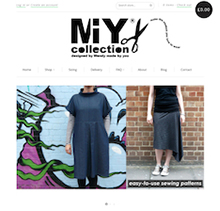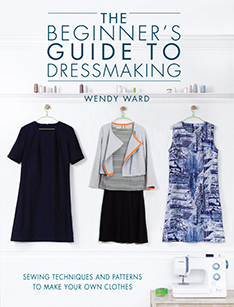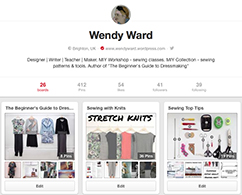 Photo © Julian Ward
Photo © Julian Ward
I think fabric dictionaries are difficult without physical samples for a bit of touchy feely! But, every little helps, especially when you first start sewing and especially when most sewing patterns contain a list of “suitable fabrics” which may mean nothing to you! (Scroll to the bottom of this list of fabrics for a list of my recommendations for where to buy your fabrics.)
So, let’s start with some basics; the important and fundamental difference between Fibres and Fabrics. Yes they are different things! A Fibre is the raw material that a Fabric is made up of such as cotton. Fabric is the resulting cloth that can be made in lots of different ways, through different weaves and by knitting. The best way to explain the difference is probably with an example: Cotton Jersey and Viscose Jersey – they are the same “type” of fabric (Jersey), but made from different fibres (one Cotton, one Viscose). As you start to make your own clothes it is important to start to learn about the properties of different fibres so that you can start to choose the most appropriate fabrics for what you’re making.
Here are some common Fibres and Fabrics:
Bamboo – bamboo plants can be turned into fibre for fabrics, which feels and behaves a lot like cotton being soft and absorbent. It’s championed as a sustainable natural fibre and there are claims it has antibacterial qualities.
Bouclé – fabric usually made from wool yarn which has irregular loops around it which creates a textured surface on the fabric. Good for making unstructured, jackets, coats.
Calico – plain woven fabric in cotton, usually unbleached. Useful for making toiles or sample/prototype garments.
Canvas – plain woven (sometimes twill), but often quite medium or heavy weight fabric usually in cotton. Good for hardwearing structured garments such as trousers, jackets, dungarees. Also known as “duck” or “sailcloth”.
Chambray – plain woven fabric that looks like a light shirting weight version of denim. Usually cotton and woven from fine threads with a coloured thread on the warp and white on the weft giving the denim look. Great for shirts and summer dresses.
Cotton – natural fibre from the cotton plant, is absorbent, but can take a long time to dry. It can crease but is soft and strong making it popular for clothing worn next to the skin as well as clothes that need to withstand some wear and tear.
Corduroy – woven fabric, usually from cotton with a fluffy surface texture (see Pile) which is woven into ridges, creating vertical lines down the fabric. Warm and fairly hardwearing it’s good for autumn skirts, trousers and jackets.
Crêpe – lightweight woven fabric with a slightly textured wrinkled surface. Usually in silk or viscose it has a lovely drapey hang which is comfortable to wear and is great for full, draped styles – trousers, tops or dresses.
Denim – woven fabric usually in cotton which a coloured warp thread (usually blue) and a white weft giving the distinct colouring. Strong and hardwearing it’s usually medium to heavy weight and good for skirts, trousers, dresses or jackets. Gives a characteristic “utility” or “workwear” feel to any garment it’s used in. If a coloured warp isn’t used, the resulting fabric is known as “Drill”.
Elastane – (known as spandex in the US) an elastic man-made fibre often mixed with other fibres to make stretch fabrics. The higher the elastane content in your fabric, the stretchier it will be. Also known as Lycra although this is a brand name for Dupont’s elastane fibre.
French Terry – typically known as sweatshirt fabric, often in cotton, but sometimes polyester/cotton blends. Can be medium to heavy in weight, the right side is flat and smooth and looks like a knitted fabric, the back has a texture made up of loops of threads. This construction makes it comfortable to wear as the cotton is absorbent, but the textured wrong side can trap heat. The loops on the wrong side can also be brushed making it soft against the skin. Hardwearing it can be used for casual clothing such as trousers, jumpers, jackets.
Interlock – a knitted fabric which looks the same on the right and wrong side. Usually in cotton, it is a bit heavier than Single Jersey and is soft and comfortable to wear. Good for tops and dresses.
Jersey – the most basic and common knitted fabric. Can be single jersey or slightly thicker double jersey commonly cotton, wool or silk.
Lawn – woven fabric, usually in cotton but can also be linen. Uses very fine threads and is densely woven which gives it a crisp lightweight finish. A good alternative for linings if you don’t like smooth shiny lining fabrics.
Linen – another natural fibre that comes from the flax plant. The main quality of linen that most people recognise is it’s tendency to crease! It is also absorbent and dries quickly making it cool to wear. It is twice as strong as cotton so good for garments subject to some wear and tear.
Marl or Melange – a colour effect usually found in knitted fabrics in which 2 different colours appear blurred. The most recognisable example is grey marl sweatshirt fabric. It is made by combining two different coloured yarns in the thread which is used to construct the fabric.
Muslin – very loosely woven fabric, usually cotton. Useful for making “Pressing cloths” (see Sewing Dictionary).
Nylon – a man-made fibre which originates from oil. It is strong, can be wind and water resistant and dries quickly making it popular for use in outdoor clothing and equipment. As it is sensitive to heat it must be washed and ironed on a low temperature. It isn’t absorbent and so can be uncomfortable to wear in heat, this also makes it prone to becoming static.
Polyester – another man-made fibre, derived from petro-chemicals. It is strong, naturally water resistant and so dries quickly. Because Polyester is crease-resistant it is often blended with other fibres such as cotton. It isn’t absorbent and so can be uncomfortable to wear in heat, this also makes it prone to becoming static.
Ponte Roma – sometimes called ponte roma or just ponti or ponte, or roma! Ponte di roma means Roman Bridge, which describes the texture on the surface of the fabric. It’s another type of double knit interlock fabric which usually is quite thick and heavy and so can be used for more structured dresses and jackets. Is usually a synthetic fibre, often a mix of polyester and viscose and can also contain Lycra.
Satin – describes the type of weave used in the fabric. The weft threads tend to be a light lustruous fibre and it results in a lightweight fabric which has a sheen to the right side with a dull wrong side and a lovely drapey hang. Usually in silk or polyester. Great for loose, draped styles such as skirts, dresses and tops.
Sateen – woven fabric usually in cotton. The way that the threads are woven results in a smooth soft fabric with a very subtle sheen to the surface. A bit heavier than satin, great for skirts, dresses and trousers, especially with the addition of elastane.
Silk – the strongest natural fibre from the cocoon of the silk worm. The fibres are extremely long making it a lustrous fibre which creates very drapey fabrics. Silk fabrics are susceptible to moths, especially if stored unclean. It is absorbent but dries quickly making it comfortable to wear next to the skin, although this can also make it susceptible to becoming static. TIP: fabric conditioners can be a good way to reduce the effects of static in a fabric.
Sweatshirt – see French Terry.
Tweed – a woven wool fabric with quite a rough feel, often with brightly coloured flecks. Good for skirts, trousers and jackets but needs lining for comfort.
Viscose – man-made, but known as a regenerated natural fibre as it is made from wood pulp. Has a beautiful heavy drape and is absorbent making it more comfortable to wear than nylon or polyester. It can take a long time to dry though and is often prone to creasing.
Wool – natural fibre from the fleece of animals such as sheep, goats and even rabbits. It can be made into a wide range of fabrics and is naturally warm to wear. Although it is not absorbent, moisture can pass through its structure making it comfortable to wear – it is naturally breathable. Wool doesn’t need much ironing and is flame retardant. Wool fabrics have a bit of natural “give” or elasticity making them easy to manipulate as in tailoring.
WHERE TO BUY FABRIC?
Here is my list of recommended shops for buying dressmaking fabrics. They’re shops I’ve bought from personally, or trusted recommendations from people I know and the list is regularly updated.
- Cloth House – gorgeous fabric shop in Soho
- Croft Mill – ends of lines of great quality dressmaking fabrics
- Ditto – fantastic collection of dressmaking fabrics just around the corner from MIY Workshop
- Fabrics Galore
- Funki Fabrics – so many stretch knits, so many colours, so many prints!
- Minerva Crafts – a mind boggling selection of fabrics and some great knits.
- My Fabrics – online shop with a huge selection of fabrics and lots of knits.
- Only Organic Fabric – organic cotton, linen & flax and organic quilting wadding
- Organic Cotton – excellent quality organic cotton knits, including sweatshirt at affordable prices
- Rosenberg Fabrics
- Stone Fabrics – a brilliant online fabric shop – lots of knits too!
- Vend Fabrics – good quality knits in basic colours, including sweatshirt and rib



















If you use 100% cotton (like quilting cotton)for making sundresses? Or is it too stiff? Is there anyway to soften it?
LikeLike
I’d say it all depends on the style of the dress! Quilting cotton will soften up over time through repeated use and washing.
LikeLike
So glad for this site
I’m new to sewing and wanted to learn terms referring to fabric
LikeLike
Pingback: My Month on Social Media – April 2017 | Wendy Ward
Pingback: Love List no. 35 - Harts Fabric Blog: Sew Your Hart Out
Pingback: Choosing and buying fabric | Wendy Ward
Pingback: Choosing and buying fabric | Wendy Ward